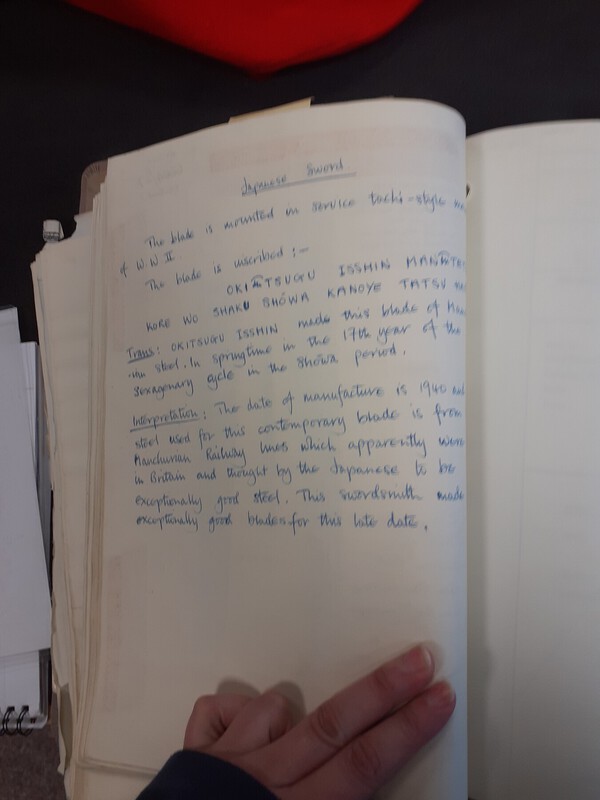-
Posts
10,879 -
Joined
-
Last visited
-
Days Won
128
Content Type
Profiles
Forums
Events
Store
Downloads
Gallery
Everything posted by Bruce Pennington
-
And here: http://ohmura-study.net/767.html
-
Bruce, Bruce here, Ha! That always feels a little strange! Can you show some pictures of the backstrap and side "ears". The floral arangement shown is a "Sonin" level of possibly a Colonial Sword. Hopefully the experts will help with the kanji. To my inexperienced eye, they look like roughly cut katakana: Fu フ Ni ニ Wo ヲ Ka カ If correct, I don't know what that would signify.
-
Jacques, I have found myself in your shoes a couple of times debating with Nick Komiya about things that didn't fit regulations. In both cases, he was adamant that Army personnel wouldn't violate regulations, but in both cases I had actual swords and/or photos that showed that they did! So, yes, I am a realist (heck, I was in the military myself and know of a guy, who knows of a guy, that had a friend that defied regulations a time or two! HA!) and know that Japanese personnel didn't always follow the regs. HOWEVER, like my cases with Nick, your case hinges on having examples to back your idea. I'll repeat - every blade has to stand on it's own merit, but so far, I haven't seen a star-stamped blade that was an obvious showato. The circumstances support a presumption of innocence, unless proven guilty with some counter-evidence.
-
Ammad, The "contingency model" or Rinji-seishiki (RS) (Japanese for contingency model) was an Army-wide version, not made specifically for the RJT system. So all sorts of blades can be found in RS mounts. It was designed (did we already have this conversation?) to be cheaper than the Type 98 and more durable for field operations. But the fittings could be put on any blade. So, you'll find standard showato, gendaito, and even ancestral blades in them. The standard blades are normally found in the light tan saya with 1 release button, while gendaito are usually found in custom saya with textured lacquer and usually 2 release buttons like yours.
-
Yes, Jacques, I've read Leon's book too. Maybe you haven't been following our discussion on Arsenal Mark on RJT Sword Fittings. There you will see that I've been corresponding with Leon about our recent discoveries in RJT regulations. You will also find his revelation that after polishing a star-stamped RJT blade, himself, he now believes it to be tamahagane. I see by your number of posts, that you are not new to Japanese sword collecting. Maybe you're new to WWII gunto collecting, though? Because if you've been around long enough, you will have learned that ALL reference material - Ohmura, Fuller, Dawson, Kapp, etc - have dated material in them that recent discoveries have made obsolete. Even swordsmith interviews must be viewed with a grain-of-salt as they were simply reporting information as they understood it from their understanding of events. Leon is currently working on an updated version of his book, and I suspect that section will see a revision with new information.
-
Jacques, While it is always true that every blade must stand on it's own, your idea is just that- an idea, imagination, speculation. Here are the facts: 1. We have an IJA Regulation stating that all RJT blades will be made with tamahagane, and multi-folded. 2. We have an IJA Regulation showing that the Star is an army material stamp indicating that the material used in the manufacture of the item was provided by the army (and from item 1, we know the material provided was tamahagane). 3. We have first-hand account from Kuniie, who inspected RJT blades and put the star on them. For your idea to be true, a smith would have had to risk violating Army regulations and losing his contract, imprisonment, etc. It's just not likely, and the burden of proving your hypothesis is on you. A similar reverse conversation could be had about Sho and Seki stamped blades. We have evidence from the Seki website and Ohmura-san that blades being inspected by the Seki Cutlery Manufacturers association were all showato. Yet, there are guys who claim their blades are gendaito, and there is even a famous case where one passed shinsa and was papered. So, in this case, the evidence says that blades stamped with Sho or Seki are showato, but someone may prove their blade to be an exception if the can. The burden of proof is on them.
-

Late model War Mounts 1944 Date
Bruce Pennington replied to Swords's topic in General Nihonto Related Discussion
@Stephen is that from the blade in the ebay sale? -

Translation of Shin Gunto blade
Bruce Pennington replied to Rod Mountford's topic in Translation Assistance
Your guess is as good as mine. Predominant theory is they are assembly/fitter numbers put there to keep blade and fittings together during the whole process. Usually painted numbers are seen, but there are quite a few stamped ones. Most stamped numbers are found on RJT blades, but I don't see Takehisa on the RJT list. And there are a few in my survey that are like this one, not RJT, but with stamped numbers. I don't think they are literally batch numbers, if I understand the term correctly, as there should be duplicate numbers seen on other blades of that batch (of course, as I say that, the idea could still be correct as our sample of stamped blades is so minuscule as a percentage of the 2 million blades produced during the war!). -

Translation of Shin Gunto blade
Bruce Pennington replied to Rod Mountford's topic in Translation Assistance
Oops, didn’t think of looking there. Yes, you have the right guy. And he’s one of the few smiths with the “W” stamp. -

Translation of Shin Gunto blade
Bruce Pennington replied to Rod Mountford's topic in Translation Assistance
Uwe, I have one Takehisa recorded with a "Na" on the blade, which would fit this. I can't find him in the NihontoClub database. Do you have anything else on this smith? -

Translation of Shin Gunto blade
Bruce Pennington replied to Rod Mountford's topic in Translation Assistance
Ooo..... need more coffee....Thanks Uwe! Rod, Thanks for the pics! That stamp on the mune is the "TO" of the Tokyo 1st Army Arsenal. And if so, COULD date the blade to before WWII. Is there chance of seeing more to the date-side of the blade? And I REALLY would like to have shot of that 46. I'm doing a study/survey of blades with stamped numbers on them. I would really appreciate it! -

Identification Help WW2 Sword
Bruce Pennington replied to DaBears's topic in Military Swords of Japan
Yes. Have you posted this gunto in an earlier thread showing a view of them assembled on the blade? If not, then there is another one I saw on an NMB post. -

Translation of Shin Gunto blade
Bruce Pennington replied to Rod Mountford's topic in Translation Assistance
Rod, Akihisa was a respected smith and made many blades for the Army RJT system. Could I please get a photo of the 46? Also, is there more of the date visible? It would be higher, extending above the hole in your second photo. There could also be a star stamped near the top of the nakago (tang). But if it's all under rust, then we won't see it. How about the mounts, and a shot or 2 of the blade showing the hamon? -

Attention Mantetsu Owners: A Survey
Bruce Pennington replied to Bruce Pennington's topic in Military Swords of Japan
Found a 1940 Koa Isshin being displayed at the London National Army Museum, online museum. # Chi 128. Strangely their translation said the blade was made by "Okitsugu Isshin" and was made of rail lines in "Britain" .... well read it for yourself. The curator was kind enough to respond to my initial contact and we're getting it straightened out. I'm still a bit shocked that such a prestigious museum would have someone translating swords that clearly doesn't know WWII Japanese swords. I understand how many kanji have multiple sounds/meanings, but this one is pretty bad. Pages provided by the curator: Survey update - Over 250 blades recorded, 237 of them with date, mei, & serial number (the rest are missing serial number or date, etc). Lion's share of blades are in the 1941-1943 years. YEAR 1937 1938 – 12 1939 - 18 1940 - 35 1941 - 55 1942 – 53 1943 – 59 1944 – 16 1945 – 7 -

Identification Help WW2 Sword
Bruce Pennington replied to DaBears's topic in Military Swords of Japan
Frank, Personally, I think this is likely to be quite a nice blade and may be worth a professional polish. It would be a shame to sell it, unless you are simply not interested in the collecting hobby. The seppa (metal spacers) are unique, I've only seen this style once before - maybe @PNSSHOGUN can refresh my memory where - and the large number of them speaks of a custom job (not to mention the extra verbiage on the nakago!). For $2-300 you can get the handle re-wrapped, but the polish will run over $2,000. But I think this gunto would be worth restoration. And BTW, thanks for posting as the smith's personal kao is one I didn't have in the Stamps of the Japanese Sword document. I've added it to the a newer version that I'll post sometime in the future. -
Glad it helped. But I was just passing the phrase along from the wise sage @16k.
-
Understand the feeling. Just remember, we are simply caretakers for these fine blades as they travel through time!
-

Translation of both side of WW2 katana tang
Bruce Pennington replied to Revo1237's topic in Translation Assistance
Also, could I get a clear shot of this area above the date? Is that a stamp? Would also love to see a shot of it in the fittings. -

Translation of both side of WW2 katana tang
Bruce Pennington replied to Revo1237's topic in Translation Assistance
Ryan, I got started in collecting when I inherited my dad's Mantetsu Koa Isshin! PLEASE post a photo of the full serial number on the back edge, please, please! You can start reading about these fabulous blades on Ohmura's free website: http://ohmura-study.net/998.html Plus, @Kiipu, @16k, and I collaborated on an in-depth article describing our NMB discoveries about Mantetsu blades that weren't known when Ohmura-san wrote his webpages. I'm attaching a copy (we should probably get that posted in the Member Article section!) MANTETSU DISCOVERIES.pdf -
Ha, no book in the works. Just compiling files on all the RJT blades/smiths I can come across. I do have your name documented on this file though, so if anything like that ever happens, I promise you will be listed as the source. As to whether you should keep or sell, ..... only you can say. My collection has the gunto in it that I wanted for a purpose (I wanted a fair example of each of the services, and each of the variations), so I'll never sell mine. Some guys have more gunto than they really need, so they'll sell some and save for something special. There are a hundred different reasons guys keep or sell. That's going to depend on your collecting goals.
-
The RJT Kanetaka is the only one listed on the Nihonto Club Swordsmith listings. Of course, I have come across a smith, here or there, that wasn't on their list, but I've often seen where there were 3-5 guys that went by a same name and they were all listed. This name only has one guy listed, so my money is on the RJT one. https://nihontoclub.com/view/smiths/list?id_op=%3D&id=&name_op=contains&name=kanetaka&kanji_op=%3D&kanji=&province=All&start_era=245&school_nid=All


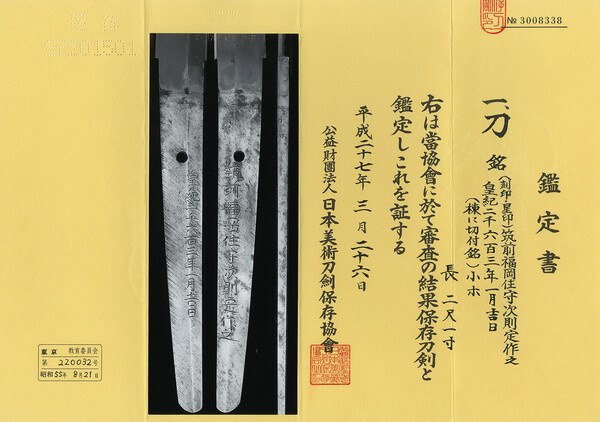
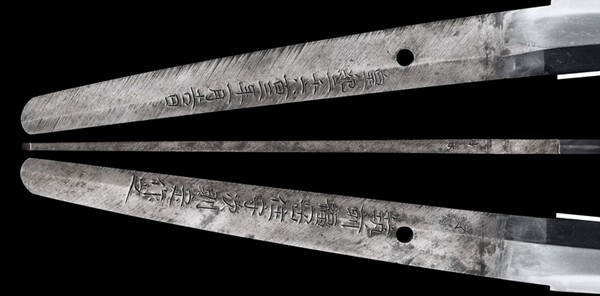


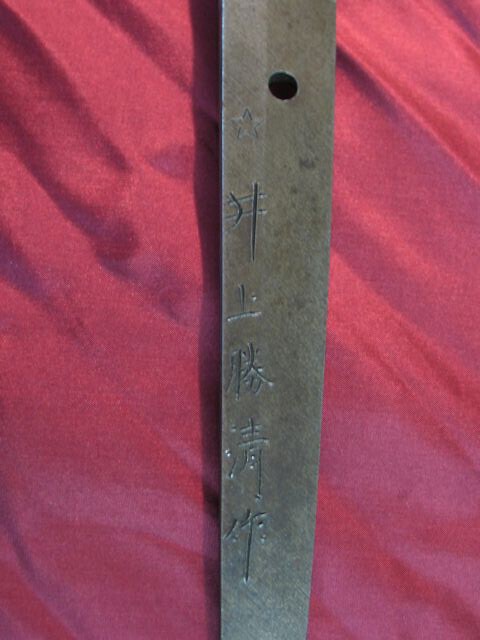
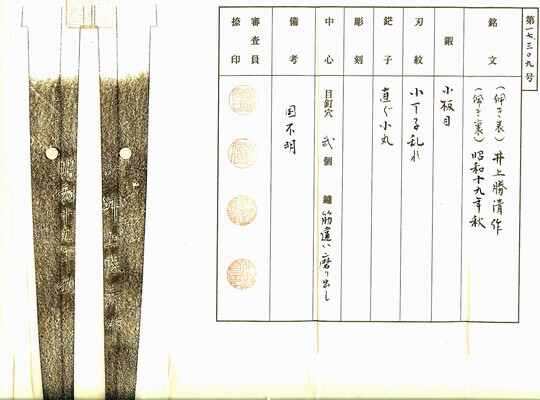

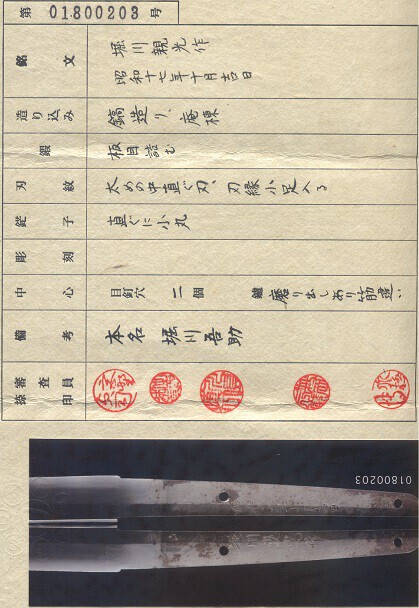





.thumb.jpg.1a1e92bed9deb8d64a9e057a6202d3a7.jpg)
